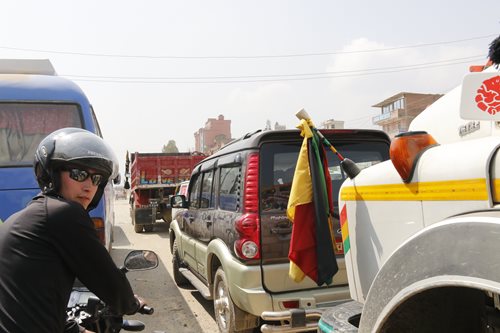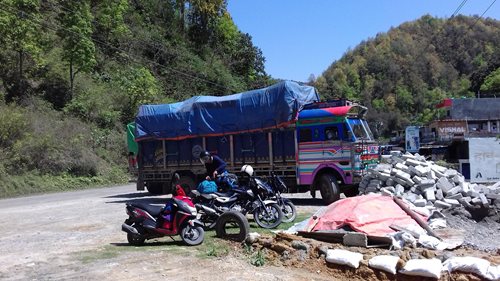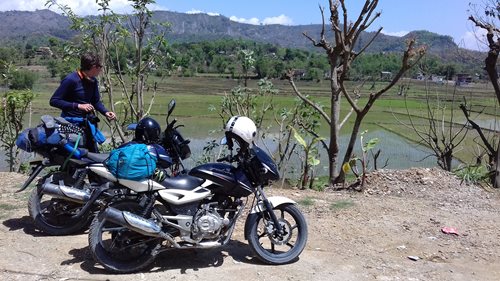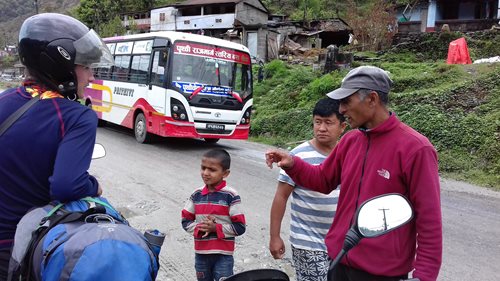Once Alex and I (on our two 150cc Pulsars) had reached Naubisi, the road was wider and less congested so we started to make better progress. We were heading west on the first day of our road trip to Mustang. Even so, unfamiliarity with the bikes and with local traffic rules meant we kept our speed down.
Probably the most alarming thing about Nepali roads is other road-users’ lack of interest in checking whether they might be about to be involved in a fatal accident. People never check when pulling out from side-streets but rely on being warned about on-coming traffic through frequent horn-use. The trouble is that horns are used a great deal to communicate other things too. Horns are sounded if you want to overtake, if you have been overtaken, if you want to undertake, if you want to communicate you have no intention of giving way when trying to force your way ahead and have no right to do so, when seeing another vehicle on the road, when seeing a friend, when seeing foreigners on motorbikes, when seeing an old woman on a bike, when moving out into traffic without looking, when forcing a way through stationary vehicles, when approaching a blind bend, when parking, when summoning passengers, when pulling out into a stream of traffic and when frustrated in a traffic jam.
As we got used to this, we did start to see the sense in sounding a horn just before overtaking. Nepali roads are in such poor condition that there’s a lot of weaving and manoeuvring along remaining pieces of tarmac or to avoid huge ruts, potholes or streams running along the road, or cows. Assiduous horn use warns the careless driver ahead not to swerve sharply into traffic as it overtakes. It actually makes very good sense. There are also pieces of advice to ponder as you drive: truck backsides are adorned with BLOW HORN or SEE YOU or USE DIPPER AT NIGHT or LOVE STAR or BUDDHA WAS BORN IN NEPAL or even DON’T TRUST GIRLS.
 |
| Feeling steamy in a traffic jam at Kalunki |
What absolutely doesn’t make sense is the use of the right indicator. People drive on the left in Nepal and so right turns mean moving across the traffic. However, indicating right seldom means ‘I’m about to make a right turn’. More usually it means it's safe to overtake me, or I am about to pull in on the left and stop, or I'm on the phone so am driving slowly and not looking where I am going, or I'm parked but still thinking about what to do next so meanwhile it is safe to come past. However, it can also me I am about to turn right so overtaking now will end in a collision. It is really very unusual indeed for people to indicate left – least of all when turning left… although it does happen, perhaps just to keep foreigners guessing.
Rights of way don’t seem to exist, nor even sometimes is it obvious which is correct side of the road. If you are ahead you can apparently cut in and even cut right across the vehicle you’ve just overtaken, and not only to avoid a head on collision. There is undoubtedly a vehicular caste system. The main rule of the road is – unless you are a cow – size is might. The kings of the road are the garishly painted trucks (lots have ROAD KING written large across their front bumpers) and the buses from whence people vomit copiously through open windows mostly say GOOD LUCK. To these truck- and bus-drivers, time is money so they will force anyone off the road (except cows). Madder still are the minibuses who drive fast, close to precipitous edges and are even more adept at forcing through where they shouldn’t. Next in the caste hierarchy are cars. As in most parts of the world taxis are the most self-assured drivers; they weave and carve their way through traffic seemingly not caring either who they force off the road. With us being beneath them in the caste system I was forever calculating what would happen if I was forced into a pothole, storm drain or gravelly pull in. But then I’m used to defensive road use. Usually I’m in the even lower caste of road user – a bicyclist. I’m accustomed to having cars driving at me from at least fiver or even six different directions at crossroad. Beneath mere cyclists are sales-people pushing barrows or carts then finally there are pedestrians: the lowest of the low.
We were both absorbing all this, our confidence growing as the miles went by.
Once we’d felt relaxed enough not to have all our attention on the changing road surfaces and other traffic, I realised that the great thing about biking is the broadness of vision. We saw rhesus monkeys on the road and in roadside trees, huge birds of prey flying low, mongooses, flowers and big gaudy butterflies. I could really appreciate the grandeur of the vast Trisuli valley – a deep V-shape cut in scree, rock and sal forest. And the sal is in flower at the moment so I kept getting lovely wafts of perfume.
As we rode on we could admire the lush new early-planted rice that people call Chaite-dhan poking through the padi fields. Then dusk began to gather, stately egrets flew home to roost and a gorgeous red sky painted everything warm colours.
It was dark and our backsides were flat by the time we made it to Lakeside in Pokhara – 10 hours after leaving Thamel. We’d covered 205km – the longest stretch on our journey.
 |
| A break for tea and samosas at a truck-stop; rebuilding is still going on apace |
 |
| From traffic jam to Chaite-dhan (early spring rice) near Pokhara |
 |
| Pausing for travel advice |
This piece is part three of a series of posts on our Mum-and-Son transHimalayan trip.… the link to the first is here
transHimalayan Adventure and the next episode is
Pokhara to Baglung.